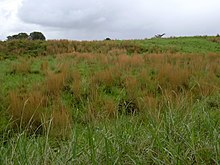
Andropogon is a widespread genus of plants in the grass family, native to much of Asia, Africa, and the Americas, as well as Southern Europe and various oceanic islands.
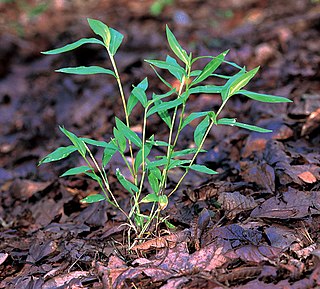
Microstegium vimineum, commonly known as Japanese stiltgrass, packing grass, or Nepalese browntop, is an annual grass that is common in a wide variety of habitats and is well adapted to low light levels.

Cabomba caroliniana, commonly known as Carolina fanwort and various other names, is an aquatic perennial herbaceous plant native to North and South America. Having been a popular aquarium plant, it has been exported around the world, and has become an invasive species in Europe and Australia.

Andropogon glomeratus is a species of grass known by the common names bushy bluestem and bushy beardgrass. This bunchgrass is native to the Americas, where it is widespread. It has also naturalized in other areas.

Cortaderia jubata is a species of grass known by several common names, including purple pampas grass and Andean pampas grass. It is similar to its more widespread relative, the pampas grass Cortaderia selloana, but it can get quite a bit taller, approaching seven meters in height at maximum.
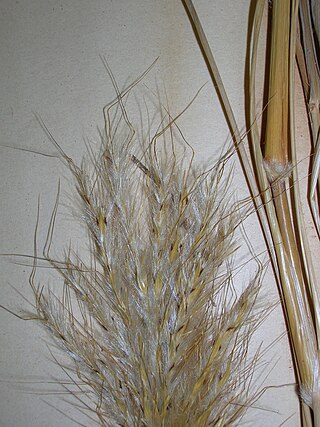
Bothriochloa barbinodis is a species of grass known by the common name cane bluestem. It is native to the Americas, including most of South and Central America, Mexico, and the southernmost continental United States from California to Florida.

Cytisus multiflorus is a species of legume known by the common names white broom, white spanishbroom and Portuguese broom.

Ehrharta calycina is a species of grass known by the common names perennial veldtgrass and purple veldtgrass.
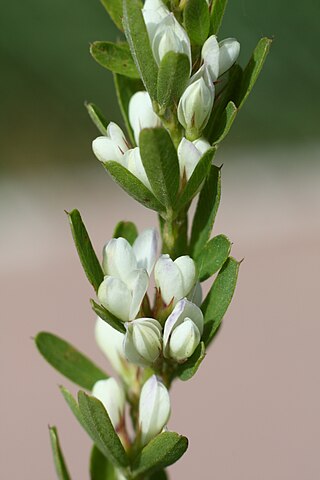
Lespedeza cuneata is a species of flowering plant in the legume family known by the common names Chinese bushclover and sericea lespedeza, or just sericea. It is native to Asia and eastern Australia and it is present elsewhere as an introduced species and sometimes an invasive plant.
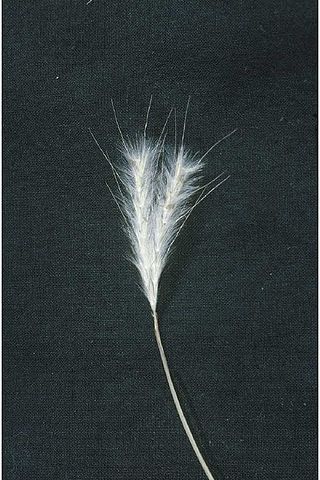
Andropogon ternarius is a species of grass known by the common names split bluestem, splitbeard bluestem, silver bluestem, and paintbrush bluestem. It is native to the southeastern, east-central, and south-central parts of the United States, where it occurs from New Jersey south to Florida and west to Kansas, Oklahoma, and Texas.

Amphicarpum muehlenbergianum is a species of grass known by the common names blue maidencane, Muhlenberg maidencane, and goobergrass. It is native to the southeastern United States.
Andropogon capillipes is a species of grass known by the common name chalky bluestem. It is native to the southeastern United States as far west as Texas.

Eragrostis variabilis is a species of grass known by the common names variable lovegrass, kawelu, emoloa, and kalamalo. It is endemic to Hawaii, where it occurs on all the main islands plus Kure Atoll, Midway Atoll, Pearl and Hermes Atoll, Lisianski Island, Laysan, and Nihoa.
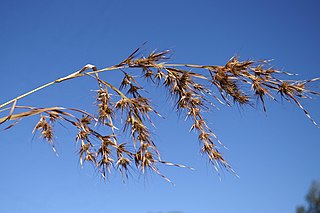
Themeda quadrivalvis is a species of grass known by the common names grader grass, habana grass, and kangaroo grass, not to be confused with Themeda triandra, which is also known as kangaroo grass. It is native to India, Nepal, and Malaysia. It can also be found in many other places as an introduced species and often a noxious weed. It occurs in the United States, New Caledonia, Fiji, Mauritius, Thailand, Indonesia, Papua New Guinea, China, the Middle East and tropical America. It is a troublesome exotic weed in Australia, especially in northern regions. It is also an agricultural weed in crops such as sugar cane and lucerne.
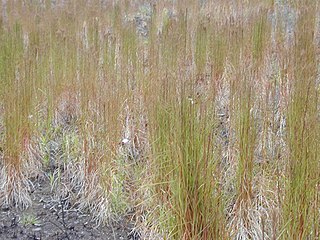
Schizachyrium condensatum is a species of grass known by the English common names Colombian bluestem, bush beardgrass, and little bluestem, and the Spanish common names aguará ruguay and yerba barbuda. It is native to South America, and it is well known in other places as an introduced species and noxious weed, particularly in Hawaii.

Brachiaria mutica is a species of grass known by the common names para grass, buffalo grass, Mauritius signal grass, pasto pare, malojilla, gramalote, parana, Carib grass, and Scotch grass. Despite its common name California grass, it does not occur in California; it is native to northern and central Africa and parts of the Middle East, where it is cultivated for fodder. It was introduced elsewhere and it is now cultivated throughout tropical regions of the world for this purpose.

Cyrtandra heinrichii, known as ha'iwale or lava cyrtandra, is a perennial flowering plant in the family Gesneriaceae. It is found on the Hawaiian island of Kauai.

Escaped plants are cultivated plants, usually garden plants, that are not originally native to an area, and due to their dispersal strategies, have escaped from cultivation and have settled in the wild and bred there, whether intentionally or unintentionally. Escaped plants are purposefully introduced plants that have naturalized in the wild and can develop into invasive plants, the settlement of which is to be assessed as problematic. Other commonly used terms include escaped garden plant, garden escapee, escaped ornamental or garden refugee.
